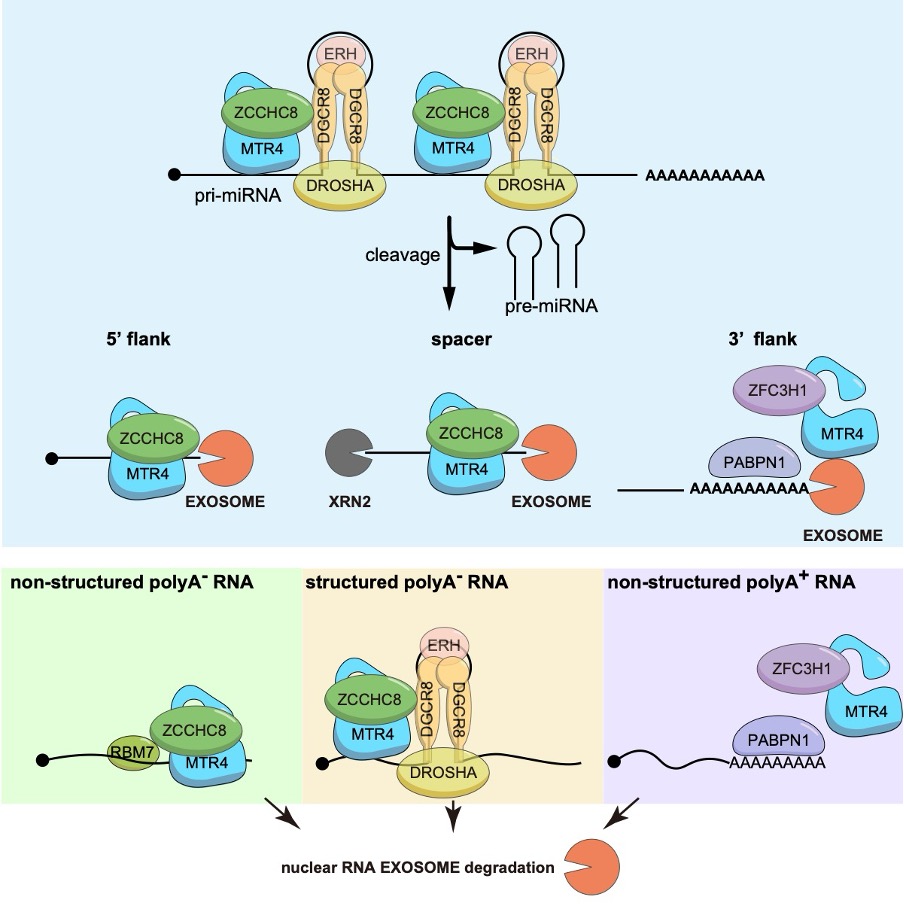En ny variant af NEXT-komplekset styrer nedbrydning af foldede RNA-molekyler
Forskning fra Torben Heick Jensens gruppe ved Institut for Molekylærbiologi og Genetik tilføjer et nyt lag af kompleksitet til selektiv RNA-nedbrydning. Forskerne har opdaget et adaptor-kompleks, vNEXT, som genkender RNA-molekyler baseret på deres foldning frem for deres sekvens.

RNA degradation is essential for RNA quality control and for removing by-products from RNA processing events. In the nucleus, the RNA exosome reigns as the major decay complex, involved in the degradation of virtually all transcript types. However, the exosome does not work in isolation but relies on so-called adaptor complexes, helping to distinguish and target RNAs for decay. Research from Torben Heick Jensen’s laboratory has previously identified two major nuclear adaptor complexes, NEXT and PAXT, which recognise different RNAs based on their 3’ end status.
A new study published in Molecular Cell and spearheaded by postdoc Katsutoshi Imamura from the Jensen team, now uncovers a further twist to NEXT-mediated RNA degradation. A variant form of the NEXT complex (vNEXT) is described, which comprises the MTR4 and ZCCHC8 proteins but lacks the canonical NEXT component RBM7. Instead, vNEXT interacts with the Microprocessor complex, which is responsible for the early processing of pre-microRNAs (pre-miRNAs) - key regulators of gene expression. Microprocessor, via its DGCR8 subunit, recognises distinct stem-loop structural elements, allowing the associated DROSHA enzyme to cut out the pre-miRNA. However, the remaining leftover RNA must be removed from this processing reaction. Imamura et al. demonstrates that vNEXT, via its connection to the Microprocessor, is one mechanism that mediates this process. Furthermore, vNEXT is shown to be able to degrade other stem-loop-containing RNAs, beyond its repertoire of pre-miRNAs.
While past studies focused on RNA degradation based on the sequence at the targeted site, this study considers the structural context of RNAs. The different dedicated targeting and adapter configurations of the RNA exosome underscore the importance of efficient RNA degradation to keep our cells free of unnecessary RNAs.
The research paper
A functional connection between the Microprocessor and a variant NEXT complex. Katsutoshi Imamura, William Garland, Manfred Schmid, Lis Jakobsen, Kengo Sato, Jérôme O. Rouvière, Kristoffer Pors Jakobsen, Elena Burlacu, Marta Loureiro Lopez, Søren Lykke-Andersen, Jens S. Andersen and Torben Heick Jensen. Molecular Cell. 84. 1-17. https://doi.org/10.1016/j.molcel.2024.10.015
SUPPLEMENTARY INFORMATION
We strive to ensure that all our articles live up to the Danish universities' principles for good research communication. Against this background, the article is supplemented with the following information:
Study type:
Research article
External funding:
Conflict of interest:
The authors declare no conflict of interest
Contact information:
Professor Torben Heick Jensen
Department of Molecular Biology and Genetics
Aarhus University, Denmark
thj@mbg.au.dk
